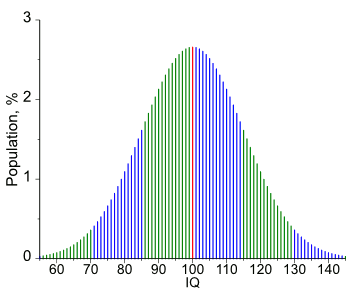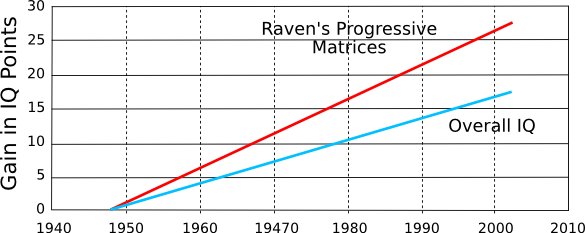Rising IQ
April 6, 2015
Parents are generally
proud of their
children. In the extreme example of "
helicopter parenting," some parents will go to extremes to
chaperone their children through the battlefield of the
educational system. Unfortunately for
teachers and
school administrators, their little Johnny, or Janie, can do no wrong; and, of course, these children are unrecognized
geniuses.
Intelligence is an admired trait in humans, and it's apparent that the degree of intelligence among people is not uniform. To gain an understanding of
variables,
scientists try to quantify them so that the variability can be
mathematically analyzed. For this purpose,
psychologist, Lewis Terman, who was also a president of the
American Psychological Association, invented the
Stanford-Binet IQ test to produce a numerical figure of intelligence.
I've written a few previous articles about intelligence (Decline in Intelligence? June 14, 2013,
Fractional Intelligence, June 29, 2012, and
Extreme Intelligence, October 14, 2011). IQ, or
Intelligence Quotient, is the supposed quantity of intelligence for an individual.
The designation, "quotient," refers to the original idea that what's being measured is the
ratio of a person's "mental age" to his physical age; that is, a child of ten with the knowledge of a typical child of twelve would have an IQ of 120. This is the ratio of 12 to 10,
normalized to 100% (100 x 12/10). Today, IQ is a
statistical concept that refers to the well known bell curve distribution, as shown in the figure.

Idealized distribution of IQ Scores.
The mean is 100, and the standard deviation is 15.
It can be seen from the curve that IQ scores below 60 and above 140 are very rare.
(Graph by Alessio Damato, via Wikimedia Commons))
One criticism of IQ tests is that they are
culturally biased and assess not intelligence, but a perception of what's intelligent. One
psychology book that I read many years ago gave the following example. A question on an IQ test presented the subject child with a blank
rectangle representing a
field, and asked what path the child would take to find a lost
ball in the field.
The expected answer was a
serpentine course through the rectangle. One
farm child, confused as to why a ball couldn't be seen in an open field, drew
tree stumps in the rectangle and a path that looked behind each stump. That would be a
logical answer for a child growing up amid tree stumps rather than regularly arrayed
city streets.
One early response to such criticism was a non-
verbal intelligence test devised by
John C. Raven as his
Master's thesis project in 1936. The
graphical multiple choice questions of this test, now known as
Raven's Progressive Matrices, are presented in increasing difficulty. An example of one such question appears below. One interesting fact is that
Asperger and
autistic individuals achieve high scores on the Raven test.[1]

An example question from an intelligence test known as Raven's Progressive Matrices.
The images show a clockwise migration of the shaded area.
(Colorized version of a Wikimedia Commons image.)
For some reason, the scores on IQ tests have been increasing over the years, and the Raven scores have been rising most rapidly. This effect, named the
Flynn effect after its discoverer,
Jim Flynn, is quite pronounced, as the
graph shows. The effect is demonstrated by having today's test subjects take the intelligence tests of yesteryear. When they do, they score higher than the original test takers.[2]

Increase in intelligence test scores over the years. (Graph rendered using Inkscape from data in James R. Flynn, "What Is Intelligence: Beyond the Flynn Effect")
In 1982, Flynn discovered that whenever intelligence tests were revised, the test developers would administer both the older and revised tests to a
panel of subjects, He found, also that the subject panel achieved a higher IQ score on the older test than the newer one. This seeming increase in intelligence was striking. The average person today has an IQ of 130 when scored by a hundred year old intelligence test. Conversely, people of yesteryear would appear to have an IQ of just 70 if scored by today's tests, and this would rank them as
mentally deficient.[2]
This increase in apparent IQ of about three points per decade was verified for the Raven test in a study just published in the
journal,
Intelligence.[4]
Peera Wongupparaj,
Veena Kumari, and
Robin G. Morris of
King's College (London, UK) looked at 64 years of scores on Raven's Progressive Matrices tests for 202,468 participants in 48
countries. They found not only that the IQ scores from these tests were increasing and that participants from
developed countries had higher scores, but that the rate of change was higher in
developing countries; that is, the developing countries were catching up with the developed world.[2,4]
While no consensus
theory has emerged as to why IQ scores are increasing, there are a lot of
hypotheses. One hypothesis is that modern people are just better test takers. Parents wouldn't spend so much money on
SAT preparatory courses if such skills didn't help. Another hypothesis championed by Flynn, himself, is that people now think more logically and hypothetically.[3] In the past, the emphasis in
education was on amassing facts; thus, the idea that memorizing the
capitals of the
US states was an important task. Today, people who can function abstractly to "
connect the dots" do better in life than those who can
recite a
poem by
memory.
A
BBC article recites quite a few possible reasons for a rise in intelligence test scores. These include parents' pushing their children to excel at an early age;
elderly less burdened by
disease;
artificial lighting; and better
nutrition.[2] There's also the idea that we live in a more
visual world, with
television,
color magazines, the
Internet, and
video games preparing us to excel on visual tests such as Raven's Progressive Matrices.[2]
Humans strive to
adapt to their
environment; and, as Flynn remarks in a
TED talk, just 3% of Americans held "
cognitively demanding" jobs in
1900, while the percentage is now 35%.[3] However, lurking beneath all these hypotheses is the idea that intelligence tests might not really be doing a good job of measuring
general intelligence.

James R. (Jim) Flynn.
Flynn is an emeritus professor of political studies at the University of Otago, Dunedin, New Zealand.
(Wikimedia Commons image by Bryce Edwards.)
![]()
References:
- Michelle Dawson, Isabelle Souli&egrace;res, Morton Ann Gernsbacher, and Laurent Mottron, , "The Level and Nature of Autistic Intelligence," Psychological Science August, vol. 18 no. 8 (August, 2007), doi:10.1111/j.1467-9280.2007.01954.x, pp.657-662.
- William Kremer, "Are humans getting cleverer?" BBC World Service, March 1, 2015.
- James Flynn: Why our IQ levels are higher than our grandparents', TED talk, March, 2013.
- Peer Wongupparaj, Veena Kumari, and Robin G. Morris, "A Cross-Temporal Meta-Analysis of Raven's Progressive Matrices: Age Groups and Developing versus Developed Countries," Intelligence, vol. 49 (March-April, 2015), pp. 1–9, doi:10.1016/j.intell.2014.11.008.
Permanent Link to this article
Linked Keywords: Parent; pride; proud; child; children; helicopter parent; chaperone; educational system; teacher; school administrator; genius; intelligence; human; variable; scientist; quantification; quantify; mathematics; mathematically; analysis; analyze; psychologist; Lewis Terman; president; American Psychological Association; invention; invent; Stanford-Binet Intelligence Scales; Stanford-Binet IQ test; Intelligence Quotient; quotient; ratio; normalization; normalize; statistics; statistical; normal distribution; bell curve distribution; expected value; mean; standard deviation; Wikimedia Commons; culture; cultural; psychology; rectangle; field; ball; serpentine; farm; tree stump; logic; logical; city street; word; verbal; John C. Raven; Master's thesis; graphics; graphical; multiple choice; Raven's Progressive Matrices; Asperger syndrome; autism; autistic; clockwise; Flynn effect; Jim Flynn; Cartesian coordinate system; graph; Inkscape; James R. Flynn, "What Is Intelligence: Beyond the Flynn Effect"; human subject research; intellectual disability; mentally deficient; scientific journal; Peera Wongupparaj; Veena Kumari; Robin G. Morris; King's College (London, UK); country; developed country; developing country; theory; hypothesis; SAT; education; capital city; US state; connect the dots; recitation; recite; poetry; poem; memory; BBC; old age; elder; disease; artificial lighting; nutrition; visual perception; television; color; magazine; Internet; video game; adaptation; adapt; environment; TED conference; cognition; cognitively demanding; 1900; general intelligence; emeritus professor; political science; political studies; University of Otago; Dunedin, New Zealand; Bryce Edwards.